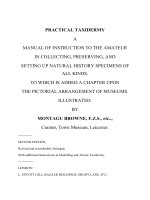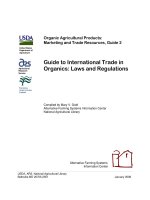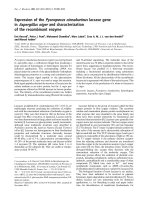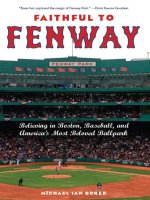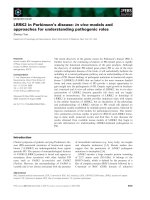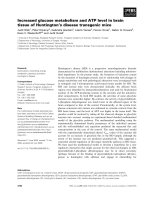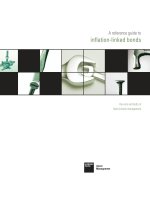FAITHFUL TO FENWAY Believing in Boston, Baseball, and America’s Most Beloved Ballpark pdf
Bạn đang xem bản rút gọn của tài liệu. Xem và tải ngay bản đầy đủ của tài liệu tại đây (943.66 KB, 276 trang )
Faithful to Fenway
FAITHFUL TO
FENWAY
Believing in Boston,
Baseball, and America’s
Most Beloved Ballpark
Michael Ian Borer
a
New York University Press
New York and London
NEW YORK UNIVERSITY PRESS
NewYork and London
www.nyupress.org
© 2008 by New York University
All rights reserved
LIBRARY OF CONGRESS CATALOGING-IN-PUBLICATION DATA
Borer, Michael Ian.
Faithful to Fenway : believing in Boston, baseball, and America's most
beloved ballpark / Michael Ian Borer.
p. cm.
Includes bibliographical references and index.
ISBN-13: 978-0-8147-9976-5 (cloth : alk. paper)
ISBN-10: 0-8147-9976-0 (cloth : alk. paper)
ISBN-13: 978-0-8147-9977-2 (pbk. : alk. paper)
ISBN-10: 0-8147-9977-9 (pbk. : alk. paper)
1. Fenway Park (Boston, Mass.) 2. Baseball—Social aspects—Massachusetts—Boston.
3. Boston Red Sox (Baseball team) I.Title.
GV867.64.B67 2008
796.357'640974461—dc22
2007043282
New York University Press books are printed on acid-free paper,
and their binding materials are chosen for strength and durability.
Manufactured in the United States of America
c10987654321
p 10 9 8 7 654321
Disclaimer: Some images in the printed version of this book are not available for
inclusion in the eBook.
CONTENTS
Acknowledgments vii
INTRODUCTION
The Sociology of Green Monsters and Broken Curses 1
BOSTON BELIEVES
Fenway Park, a “Lyrical Little Bandbox” 13
THE BIRTH OF AN URBAN BALLPARK
Leisure, Nostalgia, and the Baseball Creed 33
THE BALLPARK AT REST
The Civic Partnership between Boston, the Red Sox, and the Fenway Faithful
67
OBJECTS OF FAITH AND CONSUMPTION
Souvenirs, Replicas, and Other Representations of Fenway Park
107
SOME DIAMONDS ARE NOT FOREVER
Debating the Future of Fenway Park 133
BELIEVE IN BOSTON
Red Sox Nation and the Cultural Power of Place 179
APPENDIX
Making the Familiar Strange: Urban Sociology at the Ballpark 197
Notes 215
Bibliography 245
Index 257
About the Author 263
v
6
1
4
5
2
3
Studying the ways that people make sense of the world is impossible
to do alone. We might assume that writing is a solitary act that we do
sitting alone in our offices late at night, staring at our computers,
spending too much time scratching our heads. But no one ever writes
alone. We are social beings, even when we’re by ourselves. Not only
are the words we use somebody else’s; most of our thoughts are too.
Regardless of whether we’re writing a novel, a poem, or a sociologi-
cal study, there’s always an audience. And when you’re writing your
first book, w
hich is how this project was conceived, that audience
holds a particular and somewhat daunting level of importance. My
academic mentors provided a complicated mixture of leadership
and evaluation, guidance and judgment. They are certainly a rare
mix of academics who are not only challenging and tough, but kind
as w
ell.
This project would not have been possible without the guidance
and red ink from my adviser, Daniel Monti. He pushed me to ask the
question behind the question (and answer it) and not be afraid to take
myself less seriously and draw outside the lines. Though John Stone
spent a good deal of time trying to convince me that I should give up
this baseball thing and study a real sport like cricket, he also spent a lot
of time talking to me about this project. Our talks about sociological
theory provided me with a strong base to compare and judge my in-
terpretations and theories about civic culture and urban life. Nancy
Ammerman’s willingness to approach Fenway Park as a sacred site en-
deared me to her immediately after I first told her about the project. I
am thankful for the questions she asked me, the suggestions she made,
and the references she thought were crucial for my analysis and inter-
pretations; they all improved the quality of the work. As an anthropol-
ogist who has studied the civic culture of the United States as well as
vii
issues of authenticity, identity, and charisma, Charles Lindholm of-
fered important insights about uncovering the multiple ways that Fen-
way Park is consumed. I have admired Lyn Lofland’s work throughout
my graduate studies. I thank her not only for her academic contribu-
tions but also for her encouraging words as I began constructing a way
of understanding the cultural importance of places.
Other faculty members of Boston University’s Department of Soci-
ology who provided me with guidance, discussion, and occasionally
Red Sox tickets, include Jeff Coulter, David Swartz, Emily Barman, and
Pat Rieker. My colleagues at Dartmouth College were always eager and
excited to talk with me about my project, especially during the Red Sox
championship run in October 2004. I’m grateful for my office and the
key they gave me so I could stay there until the early hours of too many
mornings. I thank Deborah King, Kathryn Lively, John Campbell,
Denise Anthony, and Kim Albanese for their encouragement during the
later stages of writing. Special thanks go to the Women in Leadership
group at Dartmouth College’s Rockefeller Center for Public Policy and
the Social Sciences.
Leaving New England and moving to Greenville, South Carolina,
to teach at Furman University provided a little needed distance from
both the subject matter and from the anxieties of dissertationitis that in-
fected earlier drafts. My colleagues in the Sociology Department and
throughout the campus provided me with positive feedback and en-
couragement as I revised the manuscript. Special thanks go to deans
Tom Kazee and Linda Bartlett, who provided some additional funding
to help complete the book. The project became important locally be-
cause a mini–Fenway Park was built in the spring of 2006 to support the
Red Sox Single A ballclub, the Greenville Drive.
Without the help of Dick Bresciani, the Red Sox vice president and
club historian, I wouldn’t have been able to get the bat on the ball, so to
speak. “Bresch” provided me with access to the ballpark—the stands,
the executive offices, the clubhouse—and to former and current Red
Sox players and personnel. I am indebted to him for his willingness to
support this project without asking for anything in return. Thanks go to
Larry Lucchino, Janet Marie Smith, Larry Cancro, Lou Gorman, Johnny
Pesky, Carl Yastrzemski, Jim Lonborg, Mike Andrews, Dick Beradino,
Trot Nixon, Ellis Burks, Johnny Damon, Jason Varitek, and other mem-
bers of the Red Sox organization, as well as to Jim Healey of the Yawkey
Foundation, for being a part of this study.
viii Acknowledgments
I thank Richard Johnson, curator of the Sports Museum of New
England in Boston, who knows more about Boston sports history than
anyone. Erika Tarlin provided me with an entire set of Save Fenway
Park! newsletters dating from 1999 to 2006. Ed Berliner put me on tele-
vision to talk about the ballpark, Bruce Wood interviewed me and
wrote two articles about my work, and Robin Young let me speak on
NPR about the wonders of Fenway Park and Red Sox Nation. Through
those media appearances, I met people who contributed to the breadth
and scope of this project.
This book benefited from the precision editing and thoughtful ad-
vice and support from Ilene Kalish of NYU Press. Ilene and her staff, in-
cluding her assistant, Salwa Jabado, and the anonymous readers,
helped make me more comfortable as I cut out paragraphs and some-
times full pages that I had become attached to but that surely would
confuse, bore, or even annoy the reader. So, for both the reader’s sanity
and my own, I thank them greatly.
To all my friends who attended baseball games at Fenway Park, as
well as at other ballparks, I apologize for using you as test bunnies for
my new ideas about this project. But, hey, you got to see some baseball.
Witnessing the reaction of friends like Kris Nelson and Andrea Ryan
when they entered Fenway Park for the first time provided important
glimpses into the wonderment and mystique of the ol’ ballpark. Harry
Tower deserves thanks for his support. I would have had a much harder
time understanding the passion of the Fenway Faithful if I hadn’t spent
so much time as a teenager and as a young adult watching and talking
baseball with my grandfather, David Borer, and my fellow Mets mani-
acs, Dan Smalheiser, Tim Luceno, and Jon Yanovsky. I would have had
a much harder time understanding people if I hadn’t spent so much
time during graduate school talking with Thomas Nesbit.
Alan and Elizabeth Borer are two of the smartest and most gener-
ous people I know. Elizabeth’s friendship and support exceeds the
boundaries of her role as a wicked stepmother. I know my father is
proud of me. That alone makes my hard work and late-night writing
worth it. I only wish my mother could read it, not because she was a
baseball fan but because I know she would be proud too.
Acknowledgments ix
The Sociology of Green Monsters
and Broken Curses
I don’t know what’ll happen if we win [the World Series]. I mean, if we
break the Curse, well, then what? What’ll we talk about then? Maybe
they’ll get rid of the team, maybe they’ll get rid of Fenway? I don’t mean
to sound like I don’t want to win, but, what’ll that do to Boston? I mean,
Sox fans don’t know what it’s like to win. It’ll change everything.
—Pat S., Red Sox fan (comments made a few days
before the Red Sox won the 2004 World Series)
I love this place! Look how happy everyone is right now. It’s crazy out
here! I just hope nobody tries to rip down the Monster or something
because they’re so happy we broke that damn Curse.
—Jon O., Red Sox fan (comments made the night
the Red Sox won the 2004 World Series)
Even though my apartment was only a five-minute walk to the T and
then a fifteen-minute ride to Fenway Park, we decided to jump in my
car and drive down Beacon Street. We had to be prepared for what we
might encounter in the next twenty minutes and didn’t want to get
stuck in the crowd that we knew would flood Kenmore Square. When
we turned off the television and left my apartment, it was the top of the
eighth inning and the Red Sox were leading the St. Louis Cardinals
1
three to nothing in the fourth and what proved to be the final game of
the 2004 World Series. Although the game was a long way away, in St.
Louis, my childhood friend Dan had driven up the night before from
New York in anticipation of a hoped-for win and the potential chaos
that a World Series would unleash throughout the city. Even though I
lived there, we were children of suburban New York, Boston wasn’t our
city, and the Red Sox weren’t our team, though, like many Mets fans, we
tended to root for the Red Sox simply out of a shared dislike for the Yan-
kees. The magnetism of the situation, however, was powerful enough
to draw Dan north to join me and thousands of others who expected to
share a memory together, even before we experienced it.
We parked near the St. Mary’s T stop, about a five-minute walk to
Fenway but far enough away from the ballpark just in case the post-win
celebration escalated to include cars being turned over and set ablaze.
Previous celebrations in Boston in the weeks prior had set an uncom-
fortable precedent for such acts. But the fear of a loose-trigger-fingered
police force launching smoke bombs, tear gas, or rubber bullets into
masses of intoxicated Red Sox fans and drunken college kids was not
high enough to keep us away from being a part of history.
1
Whose his-
tory and why that history matters, however, were two questions
swirling in my head as we ran through the parking lot across from Fen-
way, with a radio in hand, listening, as the Red Sox took the field in the
bottom of the ninth for the last time in 2004.
Not many people who saw the Red Sox win the 1918 World Series
were living in the fall of 2004, but all Red Sox fans with a pulse felt the
burden of an eighty-six-year wait on their shoulders. One week earlier,
as the Red Sox came back against the Yankees in the 2004 American
League Championship Series, winning four straight games after being
down three games to none, the Fenway faithful in Boston and beyond
had enjoyed feelings of happiness and relief mixed with high degrees of
caution and pessimism. “Let’s not get ahead of ourselves,” warned
their collective voice. “We haven’t reached our goal yet. We still need to
win the World Series.” Much of this trepidation was because of the sup-
posed Curse on the Red Sox. Arguably, without understanding this con-
temporary urban legend we cannot understand the gravity of that night
for the Red Sox, the fans, and the city. As such, I’ll briefly introduce the
origins of the Curse and then show a few examples of the often eccen-
tric, and sometimes comedic, ways Red Sox fans have tried to either ex-
orcise or anticipate an exorcism of the Curse from Fenway Park.
2 FAITHFUL TO FENWAY
The Red Sox have been tortured by the stature of the Yankees, who
have won twenty-five championships since the Red Sox’s last World Se-
ries victory in 1918. The success of those Red Sox lay on the shoulders
of their star pitcher and future homerun marvel, George Herman
“Babe” Ruth, a.k.a. the “Bambino.” Much of the Red Sox’s World Series
woes have been credited to the Bambino and the hex he left on Boston
when he swapped his red socks for pinstripes.
Ruth was sold to the Yankees on January 5, 1920, marking a mo-
ment in Boston history that reached epic proportions after Boston Globe
sportswriter Dan Shaughnessy popularized the idea of the “Curse of
the Bambino” in 1989. The so-called Curse captivated many Red Sox
fans, even those who only believe in it purely for the sake of believing
or, for that matter, denying accountability for the litany of heartbreak-
ing defeats since the Bambino’s departure from Boston and his arrival
in the Bronx. Although there has been debate about the actual sequence
of events that led to Red Sox owner Harry Frazee’s sale of Ruth to the
Yankees, for $100,000 and a $300,000 loan to pay off the mortgage on
Fenway Park, the tragic second-place history of the Red Sox after 1918
is indisputable.
2
Even though that history is factual, it is steeped in
mythology and superstition. After Boston’s heartbreak was given a
name, and more importantly a cause, it took on a life of its own and in
some cases began to resemble the likeness of a fact.
The Curse was the type of narrative that parents reluctantly passed
on to their children along with their first Sox cap, warning them in an-
ticipation of the disappointment and distress that comes along with
being a Red Sox fan. The idea of the Curse was so commanding and
widespread that House representative Silvio Conte (R-MA) read the fol-
lowing into the Congressional Record on February 2, 1989:
those of us in New England have experienced something perhaps
more profound than victory, something that has toyed with our emo-
tions, teasing us into a frustrated state of hope and tension that has
only become bearable through years of numbing and the company of
generations of fellow Red Sox fans. Yes, it is the “near victory” that
truly tries men’s souls. Red Sox fans have felt the ecstasy of victory in
their grasps so many times, have had their fists clenched, waiting for
the final out in heady anticipation, only to be put through the agony of
another lost victory. It is a ritual that has been repeated many more
times than a kinder and gentler God would ever allow.
3
Introduction 3
Conte’s comments clearly show how the power of mythology and the
allure of the Red Sox pervade, permeate, and pummel the symbolic
boundaries between politics, religion, sports, and popular culture.
Believing in the reality of the Curse, Red Sox fans have gone to great
lengths to reverse it and restore Boston’s once-prominent winning
ways. Though many attempts were made with a touch of humor and a
bit of sarcasm, these acts were real nonetheless. Repeatedly since the
early 1990s, the “Reverse Curve” sign that hung above the outbound
lanes of Storrow Drive on the Longfellow Bridge was ritually spray-
painted by devoted fans to read “Reverse the Curse.” In 1992, a local
radio station sponsored an exorcism conducted by Father Guido Sar-
ducci, a character played by comedian Don Novello, at the corner of Ip-
swich and Van Ness streets in front of Fenway Park’s Gate B. This was
“the first exorcism of a baseball stadium ever in the history of ever,” the
good father told the crowd of over two hundred scarlet-and-blue-clad
parishioners. Pictures of the Bambino were burned, a “virgin” wearing
a plaid skirt was symbolically sacrificed, and red and white balloons
were released into the air while fans in parked cars honked their horns
in celebration.
In 2001, a thirty-seven-year-old Red Sox fan from Auburn, Massa-
chusetts, reached the summit of Mount Everest carrying a Red Sox cap
and a Yankees cap. Taking the advice of a Tibetan Buddhist lama, he de-
vised a way to bury the Curse for good, or so he thought. He left the Red
Sox cap attached to a flagpole buried deep into the snow, leaving it, lit-
erally, on top of the world (at 29,028 feet). And when he returned to his
base camp, nearly 10,000 feet below the summit, he dowsed the Yankees
cap in kerosene and lit it aflame.
Diane Dalpe and Daphne Weld Nichols performed “energy rituals”
at the ballpark in both 2001 and 2003. The two Arlington, Massachu-
setts, residents used the principles of feng shui and reiki to channel pos-
itive energy into Fenway Park. Using bits of broken glass, sage, sweet
grass, red candles, pictures of the Babe, rattles, bells, and a big pot fit for
a witch’s brew, they performed various rituals throughout the ballpark
in order to help the ballpark’s natural “chi” flow more freely.
With the permission of the state of Massachusetts, in 2002, a diving
expedition was organized in Sudbury, Massachusetts, to retrieve a
grand piano allegedly dumped into a pond by Babe Ruth when he left
New England to play baseball for the Yankees. The group hoped to re-
furbish the piano and play it again, just as the Babe did in 1918, the last
4 FAITHFUL TO FENWAY
time the Red Sox won a World Series. “We’re confident we can save it
and play it again,” said Kevin Kennedy, a member of the expedition.
“The last person to play this piano was Babe Ruth. Who knows—it
could end up at Fenway Park.”
The Fenway faithful would have to wait until October 2004 to see,
and feel, the supposed Curse lifted and their suffering redeemed. “This
is the year” became a mantra echoed throughout Red Sox Nation at the
start of each new baseball season, but 2004 proved to be “the year.”
Some claimed that they saw it coming. A little prophecy can go a long
way for people whose distress and suffering is equally matched by their
hope and faith. In September, a month before the Red Sox’s champi-
onship run, two beer vendors at Fenway Park received what they inter-
preted as an irrefutable sign that the Curse was soon to be relinquished
from the heart and soul of Boston and the rest of Red Sox Nation. Just
before the Red Sox took the field to play the Texas Rangers, the vendors
found a penny stuck to the corner of their Heineken and Miller beer
stand. The penny was from 1918. And that day, Gabe Kapler and Johnny
Damon were playing outfield for the Red Sox. Occasionally, they would
stand next to each other. Their respective numbers: 19 and 18. 1918!
Although members of the Red Sox organization, from all levels, re-
peatedly told me, “We officially do not believe in the Curse,” the mys-
tique that it brought to the ballpark is undeniable. Curses or not, no one
was quite prepared for the magic that emanated from Boston during the
2004 playoffs.
After winning four straight games against the Yankees, the Red Sox
reached the World Series since 1986, when they had lost to the New
York Mets after Mookie Wilson’s careening groundball rolled through
the legs of Sox first-baseman Bill Buckner in Game 6. The Red Sox took
the loss, but Buckner took the blame for another generation’s misery
and torment. Buckner wasn’t far from many fans’ thoughts that night in
October 2004. Many hoped that the lunar eclipse that glared above them
would keep the ghosts of Buckner and, of course, the Bambino away
from their beloved and often beleaguered Red Sox.
4
Even though the fourth and final game of the series was played in
St. Louis, hordes of hopeful fans flooded the streets around Fenway
Park. Many stood with hand-held radios or with cell phones so they
could talk to their friends and families as the game reached its desper-
ately anticipated conclusion. With two outs in the bottom of the ninth,
the Cardinals’ Edgar Renteria (wearing number 3 on his jersey, just like
Introduction 5
the Babe) hit a weak groundball back to Red Sox relief pitcher Keith
Foulke. Foulke tossed the ball underhand to first base. Renteria was
called out. The Red Sox win! The Red Sox win! And in that very mo-
ment the ballpark took on a new meaning, or at least a meaning that had
not been connected to Fenway Park since 1918: Home of the World Se-
ries Champions.
The city screamed with pangs of joy.
Boston would never be the same again.
THE IMPORTANCE OF SHARING STORIES AND PLACES
When I began doing research for this project in 2001, I wanted to know
what Fenway Park means for Boston and the people who revere the
ballpark, are near it, or hope one day to sit in one of its wooden seats.
At that time, the future of Fenway was a heated subject of debate in
Boston that only those who tried could avoid. Fenway’s future is more
secure now than it was then, but the debate still continues, though it’s
less about knocking Fenway down and more about building Fenway
6 FAITHFUL TO FENWAY
During the majority of the 2004 season, a billboard stood outside the ballpark
with the Red Sox player David “Big Papi” Ortiz looming over Brookline Ave.
demanding Red Sox fans to “Keep the Faith.” (Photo by the author)
Image not available
up, and out. Either way, the meaning of Fenway Park remains an oft-
discussed subject in and around Boston. Moreover, delving into the
depths of Fenway Park’s importance for the city and those who revere
the ballpark provided me with a unique opportunity to explore the
meaningful relationships between people and places.
Yet, although I began the project by questioning the loss of Fenway,
I was able to witness the loss of something other than the ballpark. I wit-
nessed the loss of one of Boston’s most powerful cultural narratives: the
Curse of the Bambino. But as we will see, it is the presence of Fenway
Park, as a place to commune and tell such tall tales as the Curse, that
made and will continue to make the Curse important, and not the other
way around. According to anthropologist S. Elizabeth Bird, “local nar-
ratives are . . . about how people construct their sense of place and cul-
tural identity. . . . [They] are not just about the site itself but about the
particular concerns of the people who tell the legends.”
5
In this case, the
Curse wasn’t about Fenway, but what happened at Fenway certainly af-
fected the perceived validity and vitality of the Curse. Fenway Park
outlived the beginning and ending of the Curse, providing a place
where the narrative could be passed from one generation to the next,
told and retold, believed in and broken. As such, members of the “com-
munity of believers” known as Red Sox Nation gathered near the ol’
ballpark as the Curse was broken and put away as a relic of the past
along with thousands of other local stories, dreams, and nightmares
that constitute Boston folklore. Fenway Park survived the Curse and
now stands as a reminder not of failure but of triumph.
The day after the Red Sox won the World Series was a truly strange
and unique day in Boston. I went back to Fenway Park about twelve
hours after the streets were filled with Red Sox revelers and riot police.
Though Kenmore Square and the streets that encase the ballpark were
far less populated than they had been the night before, there were now
many people eating victory lunches and buying souvenirs. A few hun-
dred people waited in line to enter the Souvenir Store on Yawkey Way
to be one of the first people in eighty-six years to wear the words
“Boston Red Sox” and “World Series Champions” on the same shirt.
The line stretched down the street, around the corner, and continued
several hundred feet down Brookline Avenue. The timing (the day after
the Red Sox won the World Series) and the place (outside Fenway Park)
added to the mystique of the sought-after treasures.
Introduction 7
The sun shone brightly above Fenway Park that day, causing some
to speak of divine intervention. But the most striking evidence that
things had changed in Boston from one day to the next was in the form
of a billboard directly outside the ballpark on the corner of Brookline
Avenue and Lansdowne Street. A billboard with a picture of Red Sox
designated hitter David Ortiz with the slogan “Keep the Faith” across
the top peered out at onlookers throughout most of the 2004 season and
into the postseason. It was replaced sometime between the end of the
celebration, which ended prematurely at about 1:30 a.m., and noon the
next day. The new billboard showed a picture of Red Sox left-fielder
Manny Ramirez with his arms stretched out in front of him and his fin-
gers pointing outward. The sign simply read, “Thank You.”
This exchange between the organization, the team, the ballpark, the
city, and the fans is about something that transcends sports and tran-
scends the individuals in the executive offices, on the field, in the
stands, on the streets, and at home in front of the television or playing
Wiffle ball in their backyards. In some ways, it was an exchange of own-
ership. By thanking their fans, the same fans who had kept their faith in
the team, the city, and the ballpark, the Red Sox recognized that they
8 FAITHFUL TO FENWAY
The Red Sox and slugger Manny Ramirez thanks the Fenway Faithful for be-
lieving in and supporting them throughout the team’s eighty-six year champi-
onship drought. (Photo by the author)
Image not available
were in possession of something that they did not, nor could not, fully
own by themselves. What was being exchanged was not a material ob-
ject or artifact. It was something much more symbolic and ethereal.
They were sharing a sense of belonging, a sense of place, and a
sense of the sacred. And they shared it with the same people who had
been sharing their time, money, and beliefs with the Red Sox for over a
century. Fenway Park not only helped make that sharing possible. It
helped make it important.
The ways that people make sense of the world they live in, once lived
in, or hope to build are tied to cultural places like ballparks, museums,
taverns, and soda shops. Many observers of contemporary American cul-
ture doubt that people appreciate such locations today. Such places are
assumed to be either mere backdrops like movie sets or signs of Ameri-
cans’ forged and fabricated culture. We are told today that the American
landscape is littered with historical façades and “theme parks” that are
devoid of spirit or authenticity. These claims give rise to criticisms that
American culture is superficial, depthless, fake, and full of kitsch.
6
But
many of these claims come from those who stand at too far a distance
from the places where people live, work, and play and who are too far
away from the culture that people make for themselves in those places.
Introduction 9
Newspaper clippings announcing the 2004 World Series win adorn the Copley
T stop in Boston. (Photo courtesy of Julian Paul Keenan)
Image not available
Regardless of the reality of the Curse, there is no doubt that Fenway
Park is real, both physically and symbolically. You can put your hands
on it, and it won’t fall down. And, apparently, you can believe in its im-
portance, and it won’t go away. I spent a lot of time at Fenway trying to
figure out what, why, and how a ballpark became and remains the most
cherished shrine of a city and a community of believers. What I found
was not only that Fenway Park was a place that people believed in but
also that important places help make believing possible, and necessary.
THE ON-DECK CIRCLE
The ways that people use, act in, and act toward an important place like
Fenway Park reveal some of the most skillful ways that people care
about, and for, their culture. Through the use of multiple methods, I
sought to uncover the logic of urban culture as it is manifested through
persons’ uses of, attachments to, and sacred reverence for Fenway Park.
Even though Fenway Park is the main subject of inquiry, it is merely
the empirical case that I am using to discuss other issues about the ways
people live in cities (and the ways cities still matter for those who live out-
side them). Moreover, I am interested in how people use places to make
sense of the urban world they live in. The theoretical position that I
adopted in order to recognize the multiple and diverse uses of the ol’ ball-
park is what I refer to as the urban culturalist perspective.
7
I “discovered”
this perspective during the gathering of data through fieldwork and while
trying to make sense of both expected and unexpected findings.
The places where we work, play, and sleep at night are culturally
important. Common and historic places, including local diners, coffee
shops, birthplaces of famous people, commemorative landmarks, em-
blematic streets and neighborhoods, sports facilities and other recre-
ation spots, provide locals, newcomers, and visitors with a “sense of
place.”
8
The fact that people care about the loss of particular places
shows at least one way that people make the city, or any area for that
matter, less “strange,” less anonymous, and less chaotic. How these at-
tachments are fostered and what places are deemed as irreplaceable
and immutable, and for what reasons and purposes, are crucial for
maintaining and reconstructing cultures inside and outside cities. And
they are crucial as subjects of inquiry for students of urbanism, civic life,
and culture in general.
10 FAITHFUL TO FENWAY
Whereas most sociologists begin with a social problem or phenom-
enon and then seek out places where that problem or phenomenon hap-
pens or happened, the urban culturalist perspective prompts the re-
searcher to begin with a place and ask an open and inductive question:
What happens or happened here? Starting from a place and then mov-
ing outward can yield important findings. Even though most sociolo-
gists take for granted the fact that culture happens somewhere, the ex-
amination of those somewheres can reveal important insights about the
use of places as meaningful community “building blocks” and per-
sonal-identity markers. Groups and individuals use shared places for
celebration, commemoration, dialogue, and protest.
9
Such places func-
tion as meaning holders that constitute “webs of significance” to be
“suspended” by and to reflect on.
10
These places are more than simply
grist for the cultural mill; they are, in actuality, where culture is empir-
ically located.
There are six areas of research that urban culturalists have con-
tributed to and continue to cultivate: (1) images and representations of
the city; (2) urban community and civic culture; (3) place-based myths,
narratives, and collective memories; (4) sentiment and meaning of and
for places; (5) urban identities and lifestyles; and (6) interaction places
and practices. These six domains, though overlapping somewhat, pro-
vide a comparative model for studying culture-place relationships in
general, while allowing for distinctions between types of places and the
people who use and inhabit them. The city and the smaller public and
semipublic places that constitute it are both symbolic and material lo-
cales that, literally and figuratively, ground people in history and tradi-
tion and help them make sense of their world.
In what follows, I present a narrative about Fenway Park that be-
gins with the rise of urban ballparks as important places steeped with
meaning and mythology and ends with the realization that reverence,
which itself is not a matter of pure consensus, does not guarantee the
survival of such places, though it certainly helps.
The first chapter introduces Fenway Park as “America’s Most
Beloved Ballpark” and poses questions about the relationships that peo-
ple have developed with and at the ballpark. Chapter 2 connects the de-
velopment of professional baseball with the growth and rise of Ameri-
can cities and shows how beliefs behind both developments left an in-
delible mark on the urban environment in the form of the ballpark. The
same motivations for building urban ballparks are still present at Fen-
Introduction 11
way Park today and are linked to what has been called the “baseball
creed.” Chapter 3 shows how the ballpark remains important even when
it is not in use as the home playing ground of the Boston Red Sox. Acivic
partnership exists between the city, the organization, and Fenway’s pa-
trons and onlookers that is mediated through various events and people
at the ballpark. As such, Fenway Park is discussed as a place where civic
culture is practiced and negotiated. Chapter 4 demonstrates another
way that important places like Fenway Park are endowed with meaning
and value, namely through the consumption of replicas, souvenirs, and
other types of memorabilia. These “objects of devotion” and “articles of
faith” are part of a feedback loop whereby they help enhance the mean-
ing and importance of the original. Chapter 5 picks apart the different
approaches to the debate about the future of Fenway and uses the debate
to make an argument about the ways that people choose to construct,
maintain, and/or reconstruct their culture through material products
that express their way of life. Chapter 6, the concluding chapter, shows
how the meanings of Fenway Park are not inherently fixed, but by using
the urban culturalist perspective we can see how and why many people
choose to make them appear permanent.
While trying to answer why Fenway Park is important, people I in-
terviewed spoke in both personal and general terms with specificity and
ambiguity. In the end, we can be sure that Fenway Park’s importance has
something to do with history and longevity. It has something to do with
beliefs about leisure time. It has something to do with the ways that peo-
ple use the ballpark for both private and public purposes. It has some-
thing to do with feelings of ownership of the place, even if only through
buying or constructing replicas and souvenirs. It has something to do
with the ways that people construct their own relationships to a place
through personal experiences and collective memories. Taken together,
these elements, along with others, constitute the complex connections
that people foster with places. Throughout the pages that follow, let’s
not take for granted the attachments that people have to the places that
help define them both individually and collectively. Rather, let’s explore
what makes a place important, how it becomes important, and why im-
portant places are necessary for the construction, maintenance, and re-
construction of urban cultures and communities.
So as they say at the beginning of each baseball game at Fenway
Park and in every other ballpark, stadium, sandlot, and backyard: “Play
ball!”
12 FAITHFUL TO FENWAY
BOSTON BELIEVES
Fenway Park, a “Lyrical Little Bandbox”
At any time of the day when you’re around that ballpark, it personi-
fies the city. Fenway’s worn at the edges like its occupants and fans.
It’s like the womb that Bostonians and New Englanders are birthed
from; it’s as if there’s a piece of Fenway in them.
—Ed Berliner, host and managing editor
of CN8 Sports New England
May the Red Sox always play at Fenway Park, and may they win the
World Series in my lifetime.
—message written on a prayer book in an ancient temple in Tokyo
Fenway Park is short on comfort but long on character. It lacks the
amenities of many of the newer sports stadiums. There is no Hard Rock
Café (as at Toronto’s Skydome), no swimming pool (as at Arizona’s
Chase Field), and definitely no sushi (which has become a fan favorite
from Seattle to Baltimore). All Fenway Park has are cramped seats,
poles that obstruct spectators’ view of the game, a daunting big green
wall in left field, a hand-operated scoreboard, and a slew of devoted pa-
trons, pilgrims, and parishioners. It is an old-fashioned ballpark in an
old-fashioned city. As the Boston Globe’s Dan Shaughnessy wrote,
“There is nothing trendy or hip about Fenway. It is NPR in an MTV
world.”
1
And yet there is something about Fenway Park, with its feet
13
1
firmly planted in the past, that makes complete sense, even in today’s
newer-than-thou world.
Walking around the outside of Fenway Park, even during the off-
season or when the Red Sox are out of town, you get the feeling that you
are treading on sacred ground and that, simply by being there, you are
a part of something special. Unlike most buildings in most cities, Fen-
way Park brings you into it, even if you’re only observing it from the
outside. You get the feeling that something has happened there and that
“something” is significant. There is a certain but hard-to-define buzz
emanating from the ballpark that demands onlookers to take notice of
it and recognize it as a place that is important to the people of Boston
who, since 1912, have invested not only time and money but meaning
and value into it.
Fenway is nothing less than a national icon, and for many people it
is Boston’s most treasured local attraction and delicacy. Not only do peo-
ple pack the ballpark on game days, but hordes of baseball fans also flock
to the bars and restaurants that surround Fenway and flow into Kenmore
Square, which is only a stone’s throw away. Certainly they could watch
the televised broadcast elsewhere, but they are drawn to or near the park
even when the team is out of town. The closer you get to Fenway and,
once inside, the closer you get to the lush green field, the closer you are
to “history.” Just by being there, you become part of a shared history of
triumph and tragedy, heroes and villains, beer and hot dogs.
People from outside of Boston, from places well beyond com-
mutable distances, regularly make pilgrimages to Fenway to pay hom-
age to one of American culture’s most cherished shrines. They take the
tours, touch the Wall and the new seats on top of it, and try to remem-
ber the things that happened there that they only know about second-
hand. They try to imagine players of yesterday, from stories that their
grandfathers told or that they only vaguely recall themselves. Memo-
ries and stories are shared about childhood heroes hitting, running,
making diving catches, or being carried off the field by excited fans after
a victory the way Jim Lonborg was after he pitched the Red Sox into the
playoffs on the last day of the regular season in 1967.
Lonborg himself still gets a bit red in the face with excitement when
he talks about that day. He was so proud to have helped Boston take a
giant leap toward the championship and share the celebration with
local fans and the city, even though people stole articles of clothes, like
his belt, while they hoisted him above their shoulders in a joyous frenzy.
14 FAITHFUL TO FENWAY

